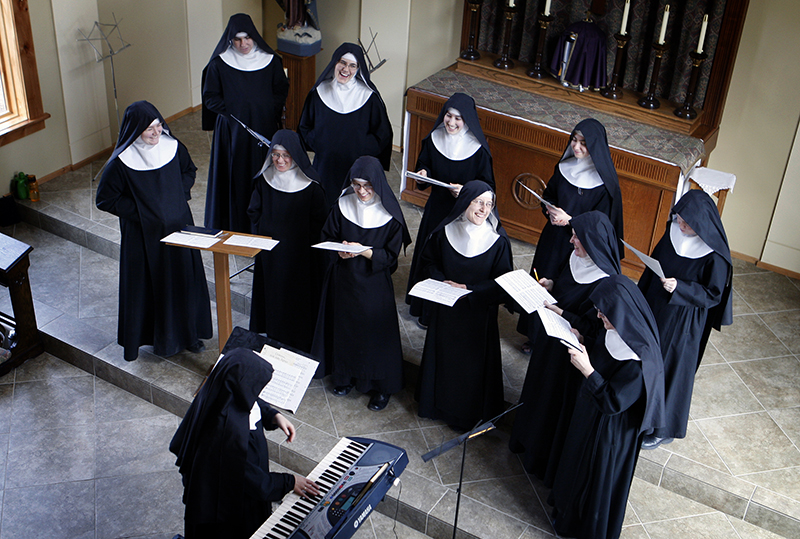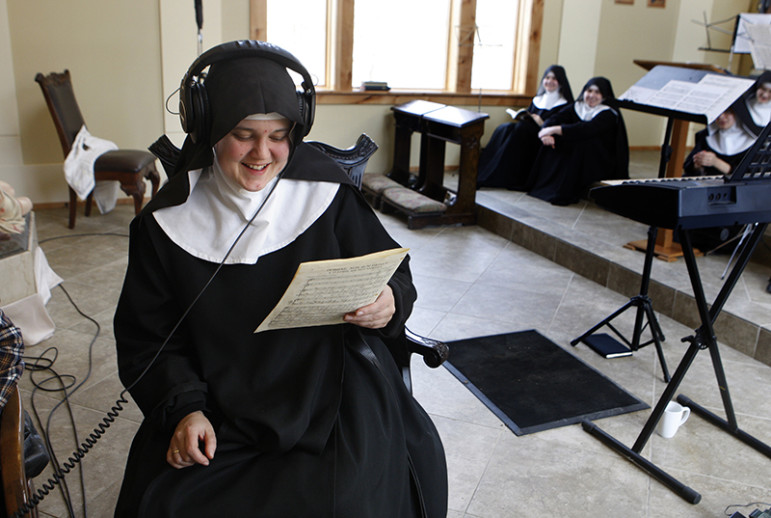GOWER, Mo. (RNS) Tucked away just off a rocky road is a small community of women who have chosen to retreat from the world and spend their days working in silence — except for when they are singing sacred music.
They are cloistered nuns, the Benedictines of Mary, Queen of Apostles. Their days consist of prayer, work and song. And when they sing, people listen. Four albums have topped the charts; their latest, “Adoration at Ephesus,” was issued this week (April 26).
Their music, which started as private prayer, has become a musical balm for a weary world in search of peace.
Many of the nuns, ranging in age from 18 to 92, don’t even know of the commercial success of their albums.

Benedictines of Mary, Queen of Apostles, record their latest album, “Adoration at Ephesus,” on February 18, 2016. Religion News Service photo by Karen Pulfer Focht
The mixture of silence and song is part of the 1,500-years-old Benedictine way of life. It is a spiritual path born out of the Catholic faith that has given the church many saints, including its founder, St. Benedict.
The nuns in Gower milk cows, gather eggs, make vestments and nurture the souls of weary priests. One of their particular specialties is hand-making church vestments.
The singing began as a way to pay for the retreat centers and living quarters they have built on a quiet hill about an hour north of Kansas City.
With the success of the albums, they’ve earned enough to build a place of quiet and solitude for priests to retreat so they can rest and renew.
The community has 25 sisters and six more may officially join by the end of the year, said Mother Cecilia, the prioress.
Many of the women have been home-schooled and “adapt very quickly,” she said. The women come from all over the country and several non-Americans will join soon.
“We are in a sense reaching back through time and conserving that way of life for the future,” she said. “These women really want to be a part of it. It is 1,500 years old, this Benedictine way of life, and it has given the church thousands of saints. They aspire to this and want to pass on that ideal.”

Benedictines of Mary, Queen of Apostles, are cloistered nuns who have had four albums top the charts. They released their latest album, “Adoration at Ephesus,” on April 26, 2016. Religion News Service photo by Karen Pulfer Focht
Mother Cecilia said most of the prayers are sung in Gregorian chant.
Prayer happens at scheduled times and spontaneously during the workday.
“We are hard workers; simple but hard work, it keeps the mind awake but we can still focus on God,” she said. “Benedictines have traditionally been tied to the land. That helps the nuns never to forget the reality that we are dependent on God, even for things like food.”
Early each morning, the nuns in their habits head to the fields to feed the livestock, milk half a dozen Jersey cows and gather eggs from some 20 hens. Later they make cheese, butter, yogurt and ice cream.
“We work in silence,” said Mother Cecilia. “We are waiting there for something very beautiful to come. The voice of our Lord comes to us in whispers, so we have to be quiet so we can hear it.”
The silence, the solitude and prayer form the inspiration for the music.
What they want more than anything is for God to use them as his instruments.
(Karen Pulfer Focht is a freelance photojournalist based in Memphis,





